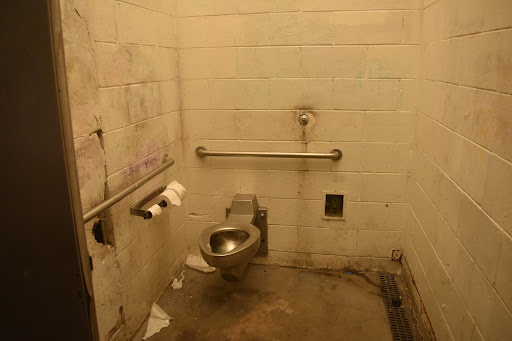
By Macy Meinhardt, Voice & Viewpoint Staff Writer
Five Grand Jury reports and one (major) hepatitis outbreak later, San Diego proposes a finalized response to claims that the city needs to prioritize the quality and quantity of public bathroom facilities in the downtown region.
To maintain San Diego’s status as “America’s Finest City,” more work needs to be done to assure residents, visitors, and the downtown workforce have access to clean and safe public restroom facilities, the report suggests.
On Monday, the San Diego City Council voted to approve a formal response to the 22-page grand jury report, highlighting numerous issues stemming from the inadequate availability of public restrooms in the downtown area, posing health and safety concerns for residents.
Given the increase of homelessness presence in downtown, the latest report underscores the urgent need for the city to address the byproduct of this crisis; the growing presence of human waste, odor, and infectious diseases resulting from poor street and bathroom sanitation.
“A lack of accessible, safe, and well-maintained restrooms, with accompanying hand-sanitation access, provides an environment that discounts the importance of dignified access to such services, increases the likelihood of human waste being found in public spaces, and has been a factor in the spread of infectious disease,” the May 2023 Grand Jury Report reads.
According to the Public Toilet Index (yes, you read that right), San Diego has 13 public bathrooms per 100,000 residents. This statistic ranks lower than other large cities in the state. Oakland, for instance, has 30 bathrooms per one hundred thousand residents, Anaheim has 25 bathrooms, San Francisco 26, and San Jose 20.
“When ‘nature calls,’ you don’t want to squat behind a tree to answer it. But even the most developed cities and towns are troublingly short on public toilets. And the issue is disproportionately more pressing on humanity’s less-privileged restroom users,” as stated in the index report.
The latest monthly homeless population count in the downtown region for September totaled up to 1,370 unsheltered individuals, according to Downtown San Diego Partnership. It’s important to note that while U.S. census records indicate that Black individuals comprise six percent of the city’s total population, they disproportionately account for 26 percent of the city’s homeless population, as indicated by demographic data from the San Diego Housing Commission.
Since 2003, the San Diego Grand Jury has proposed five different reports warning the city of the implications associated with inadequate public restroom access.
The San Diego Grand Jury comprises nineteen voluntary citizens charged and sworn to, among other things, review and evaluate procedures, methods, and systems utilized by the government to determine whether they can be made more efficient and effective.
Although the city and the mayor were initially expected to respond within 90 days of the report’s publication, they were granted an extension until Nov. 10th. Within the grand jury report, there were eight findings, and the city concurred with four of them.
One of the shared agreements agreed upon by both entities was that “adequate public restrooms may help mitigate outbreaks such as hepatitis A, shigella, and COVID-19.”
The report cites a connection between deficient bathroom access and a surge of diseases among homeless people in the downtown area. In 2017, a regional hepatitis-A outbreak stemming from exposure to human bodily fluids took 20 San Diegan lives and sickened almost 600 others. This year, in 2023, 30 cases of hepatitis-A have been reported throughout the county; 19 of those cases are of homeless people, and two people have died.
In addition, despite the ongoing health and safety risks posed by the poor bathroom conditions, the city currently has no comprehensive plan to establish, maintain, and fund restroom services, the report finds. The mayor and council agreed with this finding.
“Instead, the city’s approach to downtown restrooms has several components,” their response reads. Among others, some of these include connected plans with park facilities as part of its sheltering strategy, as well as a plan “underway” to update policies that address the need for public restrooms in the City’s General Plan.
Currently, the county and Port District oversee three permanent 24/7 public bathrooms, each equipped with security personnel responsible for ensuring patrons adhere to ten-minute usage intervals and other compliance regulations. In speaking with one of the commissioned restroom guards, who preferred not to be named, he said the majority of facility users are homeless people and that he regularly has to enforce the ten-minute rule, mitigate vandalism, drug use, and fights.
The city maintains that cleaning frequency for each restroom facility occurs “two to six times a day.”

Meanwhile, in regards to a comprehensive economic analysis on the costs of public bathrooms, the report claims that the city has none. However, the city partially disagrees, saying it does have this information; the only analysis not conducted is a review of costs attributable to the lack of adequate restrooms.
Despite the lack of formal data of this kind, speculations can arise when looking at the financial implications caused by the hepatitis outbreak for instance, since it is linked to poor bathroom accessibility among homeless individuals. According to a report released by the city in 2018, the outbreak cost the county $12.5 million.
In reference to the report’s recommendation to come up with a comprehensive plan and budget for bathrooms, the city states that it is not warranted. Instead, it defers the problem to the county since it is the leading health and human service agency for the region. In contrast, one online user commented in a forum stating otherwise.
“This is exactly what the city should be looking to spend our taxes on, because it is affecting all of us, not just homeless people. This is the city’s responsibility to create, enforce, and adapt strategies that improve our city.”
In addition, the user wrote, “San Diego deserves to be a world-class city, and no world-class city has a downtown that smells like piss on every street.”
The full itemized report by the San Diego Grand jury and the city’s response are linked in this online article for readers’ review.


